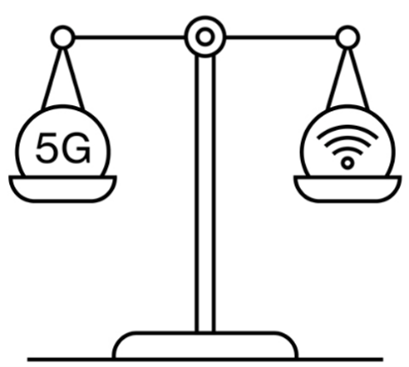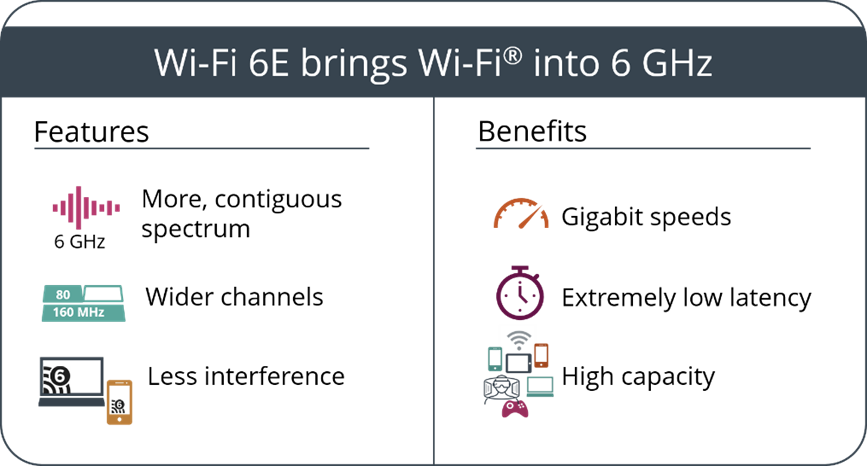Transforming Wi-Fi 6 to 6E
In Wi-Fi 6 – Deep Dive of the wireless technology series, we have covered the Wi-Fi 6 air interface (emphasizing the frequency arrangement), physical and MAC layer functionalities of different Wi-Fi generations, and IP aspects of Wi-Fi 6. This blog part will compare the Wi-Fi 6 to 5G networks, technology revolutionization from Wi-Fi 6 to Wi-Fi 6E, discuss the key features of Wi-Fi 6E, and list the top players in Wi-Fi 6 and Wi-Fi 6E.
Wi-Fi 6 vs. 5G Cellular Network
Wi-Fi is an acronym for Wireless Fidelity. It is a wireless networking technology that allows devices such as computers, laptops, smartphones, wearables, other equipment such as printers and video cameras, etc., to connect with the Internet. Wi-Fi technology comes under wireless LAN technology, which means its coverage range is limited to short distances (e.g., home, office buildings, campuses, etc.). The Institute of Electrical and Electronics Engineers (IEEE) 802.11 standard defines the protocols that enable communications with Wi-Fi-enabled wireless devices, including wireless routers and wireless access points. Almost all the latest gadgets, smart devices support IEEE 802.11 standards. The standards operate on varying frequencies, deliver different bandwidths, and endorse other numbers of channels. The operating frequency for Wi-Fi is 2.4 GHz, 5 GHz, and 6GHz (6 GHz for Wi-Fi 6E). Wi-Fi signals are sent to devices via radio waves.
Wi-Fi 6 technology is a potential competitor to 5G, as Wi-Fi 6 technology offers much lower latency than previous Wi-Fi generations, thus making it attractive for industrial applications. However, 5G provides an advantage over Wi-Fi 6 for industrial communications due to several factors, such as flexible air-interface design, support for Ultra-Reliable Low-Latency Communication (URLLC) and mobility, QoS guarantees, and better scalability.
The Usage of 5G or Wi-Fi 6 depends on the specific use case. Internet-of-things (IoT) is one of the most exciting use-cases for Wi-Fi and 5G. For example, machine-to-machine communication plays a crucial role in factory automation. While Wi-Fi 6 may work for a managed manufacturing operation, 5G may augment a large campus-wide manufacturing environment. In some use cases, Wi-Fi and 5G cellular networks can also be used together. For example, a connected vehicle may offer in-vehicle Wi-Fi services to users' devices while the car connects to a 5G network.
Deployed 5G networks are either private networks or public networks. These networks use the same underlying network solution, typically hardware, software, encoding scheme, and spectrum. A brief discussion of these two networks is given below.
Public Networks: Public networks provide all the standard features of 5G, such as faster throughput and lower latency. In particular, the general 5G network is intended for use by the public, with tens of millions of subscribers on a given network. In such networks, spectrum is usually owned by a mobile network operator, and therefore, they are responsible for service and management.
Private Networks: A private 5G network is a local area network based on new 5G radio (NR) technology and suitable for dedicated wireless connectivity in a specific area. The key feature of private 5G networks is that it allows industrial players to run their local networks with reliable equipment and settings. A private 5G network is intended for use by a single enterprise or organization, building. Private 5G networks can be deployed in three different types of radio spectrum:
The licensed spectrum includes the licensed range like public cellular networks.
Unlicensed spectrum: 2.4 GHz, 5 GHz, and 6 GHz band.
The shared licensed range consists of the US's 3.5 GHz citizen broadband radio service (CBRS) band, the 3.7 - 3.8 GHz band in Germany, and the UK's 3.8 - 4.2 GHz band.
Wi-Fi 6 to Wi-Fi 6E
Wi-Fi 6 generation of Wi-Fi technology is primarily focused on improving Wi-Fi stability in congested environments. While peak download or upload speeds seem to have improved, the primary objective is to provide a reliable internet connection to many connected devices. The number of connected devices in modern homes has increased, and this presented a challenge that Wi-Fi 6 tackled using technologies such as 1024 QAM and OFDMA. The idea is to have more simultaneous connections, use available bands more efficiently. However, overcrowding in the 2 GHz to 5 GHz spectrum has resulted in a lack of range to realize the full potential of Wi-Fi 6. Wi-Fi 6E addresses this problem by expanding the frequency band to include the 6 GHz band in the existing 2.4 GHz and 5 GHz band in Wi-Fi 6.
Wi-Fi 6E: Features and Benefits
Wi-Fi available in the market operates over 2.4 GHz and 5 GHz bands. However, the extended version of Wi-Fi 6, i.e., Wi-Fi 6E, supports the 6 GHz wireless spectrum and offers faster wireless speeds and lower latency over previous-generation Wi-Fi. This 6 GHz band has many channels and is less congested than the 2.4 GHz and 5 GHz bands. Support for such 6 GHz bands results in less interference, thus enabling Wi-Fi to support higher-bandwidth applications (such as augmented and virtual reality, remote patient monitoring, etc.) that require faster wireless speeds and low latency. These quicker wireless speeds and expected latency benefits are essential to support 5G services.
Wi-Fi 6E can access up to seven new 160 MHz-wide channels to provide faster speeds, higher capacity, and lower latency. Since the new 6 GHz unlicensed band is adjacent to the existing 5 GHz Wi-Fi spectrum, vendors can add 6 GHz capability to their devices with minimal cost to enable new capabilities and applications.
Wi-Fi 6E Air Interface
As already discussed in the Wi-Fi 6 – Deep Dive of the wireless technology series, air interface refers to the specification of the radio transmission between the transmitter and the receiver. Air interface typically defines frequency arrangement (i.e., center frequencies, the bandwidth of the radio channels, etc.), modulation techniques/ multiple access scheme, and subcarrier modulation method.
The operating frequency for Wi-Fi 6E is 2.4 GHz, 5 GHz, and 6 GHz. Their frequency channels are shown below.
6 GHz band: Wi-Fi Alliance has allocated 1200 MHz of spectrum for Wi-Fi 6E in the 6 GHz band, which will be available in a single, continuous band from 5.925 GHz to 7.125 GHz. Wi-Fi 6E will include 14 additional 80 MHz channels and seven additional 160 MHz channels. The first enterprise-grade Wi-Fi 6E access points (APs) are introduced by Aruba, available under the name "Aruba 630 Series APs".
Potential Applications of Wi-Fi 6E
Wi-Fi 6E brings significant improvements in throughput. This makes it suitable for many demanding applications and uses cases such as:
Improvements in applications
Wi-Fi 6 and Wi-Fi 6E: Top Players
Some of the top players operating in the global Wi-Fi 6 and Wi-Fi 6E chipset market are Broadcom announced World's first Wi-Fi 6E chip for mobile devices, Qualcomm Technologies Inc. ,Onsemi , Intel Corporation , Celeno, MediaTek Inc., Texas Instruments Incorporated, Cypress Semiconductor Corporation, ST Microelectronics, NXP Semiconductors.
Conclusion
The revolutionization from Wi-Fi 6 to Wi-Fi 6E is essential to meet the ever-increasing demand of users. Wi-Fi 6E takes the efficiency features from Wi-Fi 6 like Orthogonal Frequency Division Multiplexing and Target Wake Time. It extends them to the 6 GHz band to provide a more contiguous spectrum and less interference. Wi-Fi 6E brings technology advancements that enable new use-cases. Many companies have already started to work on Wi-Fi 6E devices, and Wi-Fi 6E will likely generate massive revenue opportunities in the coming years.
*Disclaimer: This report is based on information that is publicly available and is considered to be reliable. However, Lumenci cannot be held responsible for the accuracy or reliability of this data.
*Disclaimer: This report is based on information that is publicly available and is considered to be reliable. However, Lumenci cannot be held responsible for the accuracy or reliability of this data.
Author
Satyam Kumar
Associate at Lumenci
Satyam Kumar Rao Associate at Lumenci. Satyam is an Associate at Lumenci with experience in Video codec, Networking and Telecommunication. He holds a B.Tech degree in Electrical Engineering from NIT Kurukshetra. He is interested researching new advancements in technology. He enjoys drawing, painting and listing to music in his spare time.





